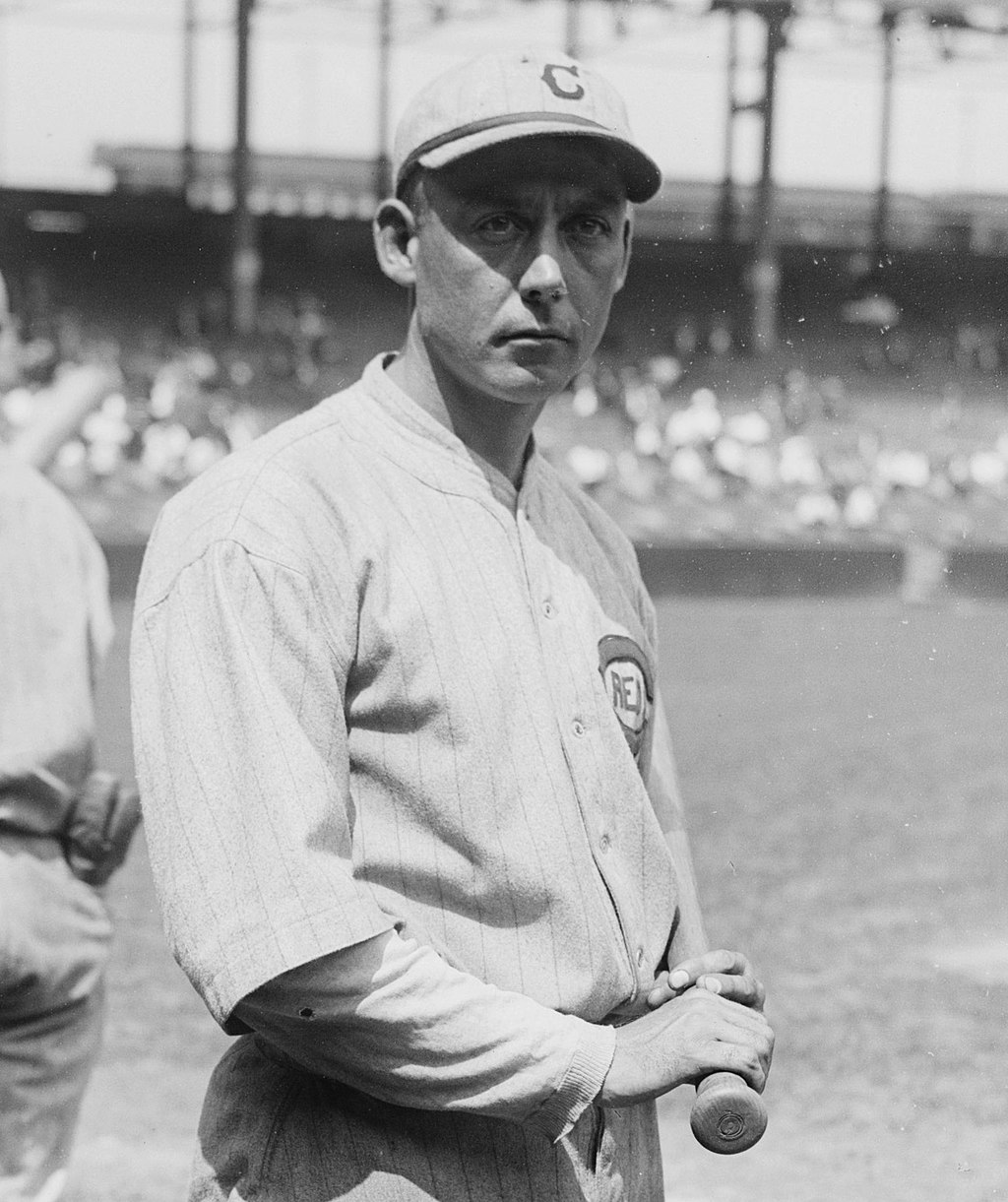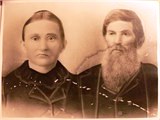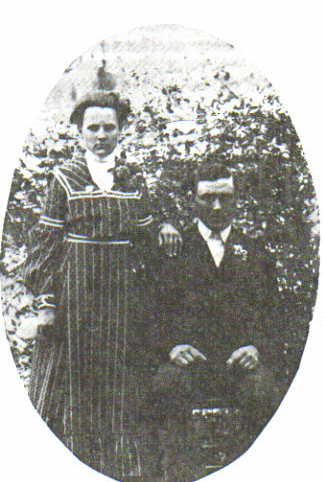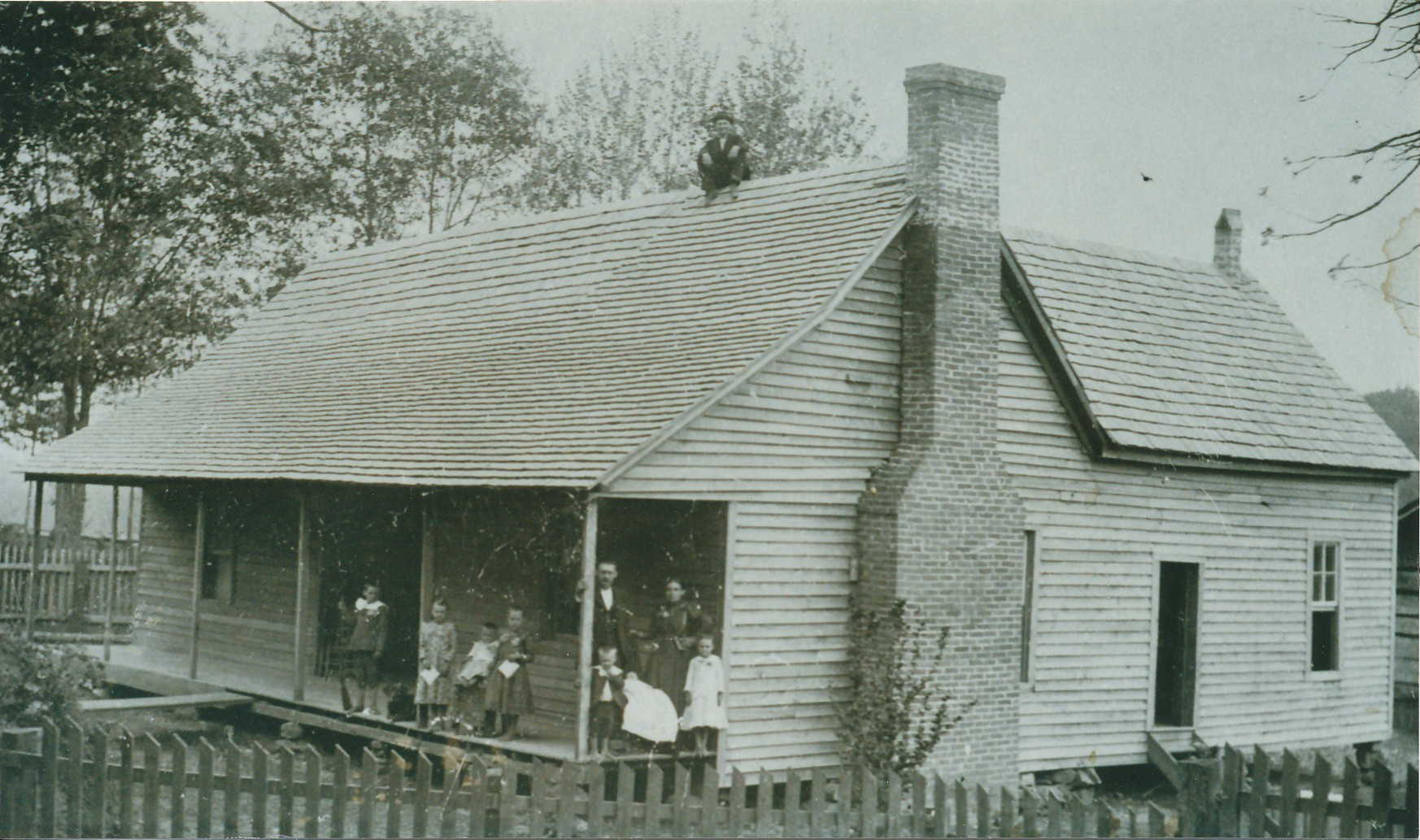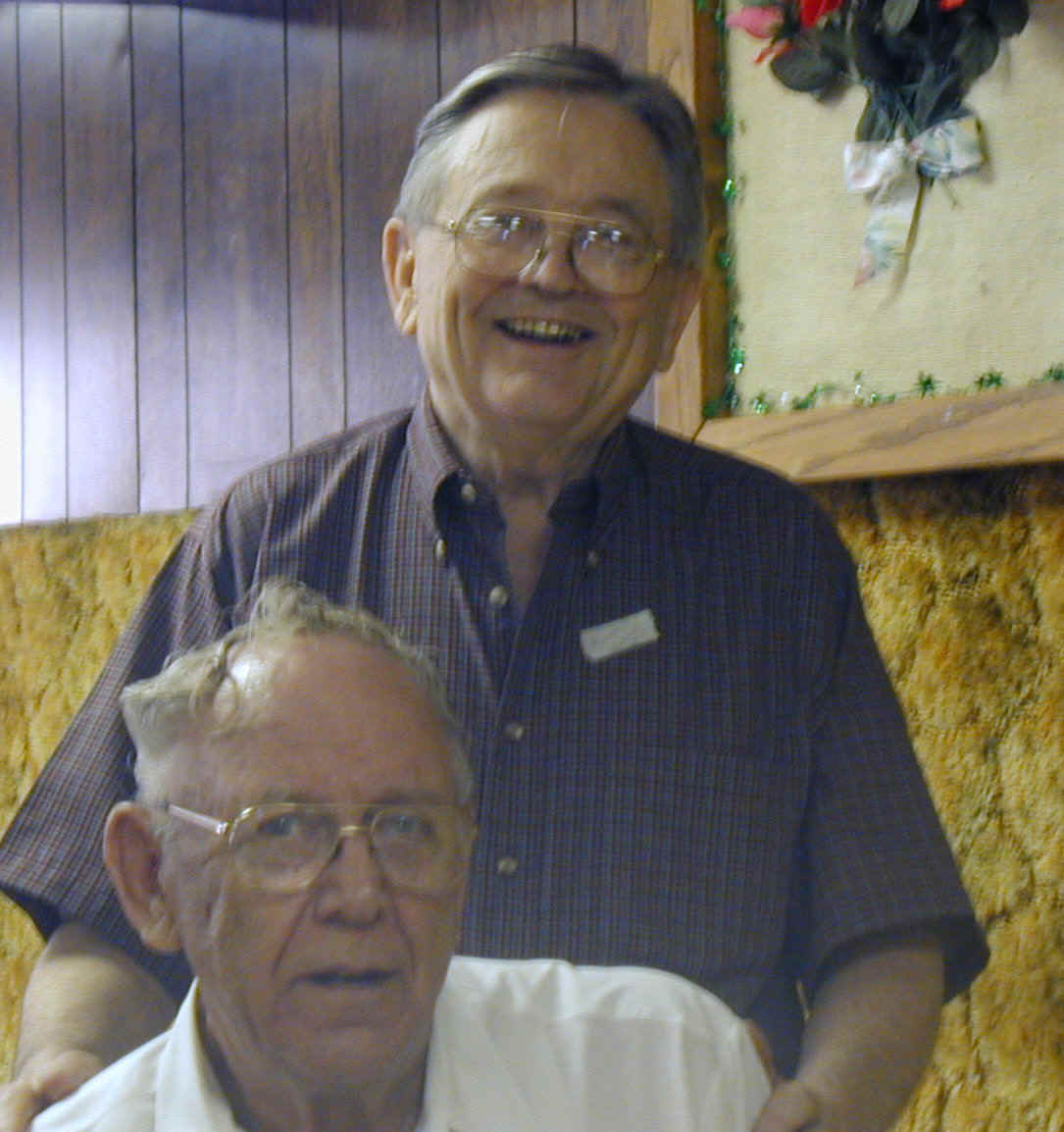Gunder Sorenson
Gunder ‘Gunnard’ Sorenson (9/20/1836 – 8/7/1905) was born in Ullensaker, Akershus Commune, Norway. He was born on the family farm, Lille Fladby, three miles NE of Klofta, one mile north of the Ullensaker church, and baptized October 23, 1836. Gunder was the fifth child and only boy. Hard times forced his father to sell a portion of the farm in in 1848, but he was able to later buy back a part of this.
Times were difficult in Norway. Unless one inherited the family gaard (farm), married into land, or worked on the seas, there was little opportunity to be successful. It is quite likely that Gunder worked the family farm until 1864 with his father, Soren Gunderson (born in Vinger, Norway in 1790). Soren died during the 1860’s, and the farm was then deeded to his eldest sister, Berte Mari Sorensdatter (ten years his senior) and her husband, Herman Arnesen. I am certain that this was extremely difficult for Gunder, as it is known that he was an extremely hardworking and ambitious man. Nonetheless it was not uncommon for a farm to be given to the eldest child, regardless of sex. Gunder married Anna Olsdatter (son of Ole) Kvarven (8/1845 – 10/22/1923) in 1872 (according to the 1900 census). Her father is listed as Ole Quarvin on her death certificate. It is most likely that they did not meet until Anna immigrated to Minnesota in 1870. On March 31, 1893, Andreas Kornelius Sorenson married Kristine Maria Nelson at Long Bridge Church in Little Sauk, Minnesota. The wedding was witnessed by both Gunder Sorenson and Fred Frederikson.
The year 1865 marked the first of three large waves of Norwegian immigration to the promised land, America. Articles proclaimed the availability of free lands available because of the Homestead Act of 5/20/1862. This constituted “An act to secure homesteads to actual settlers on the public domain.” Early emigrants were quick to confirm this with letters home. A photograph of Gunder taken in Trondheim is displayed below.
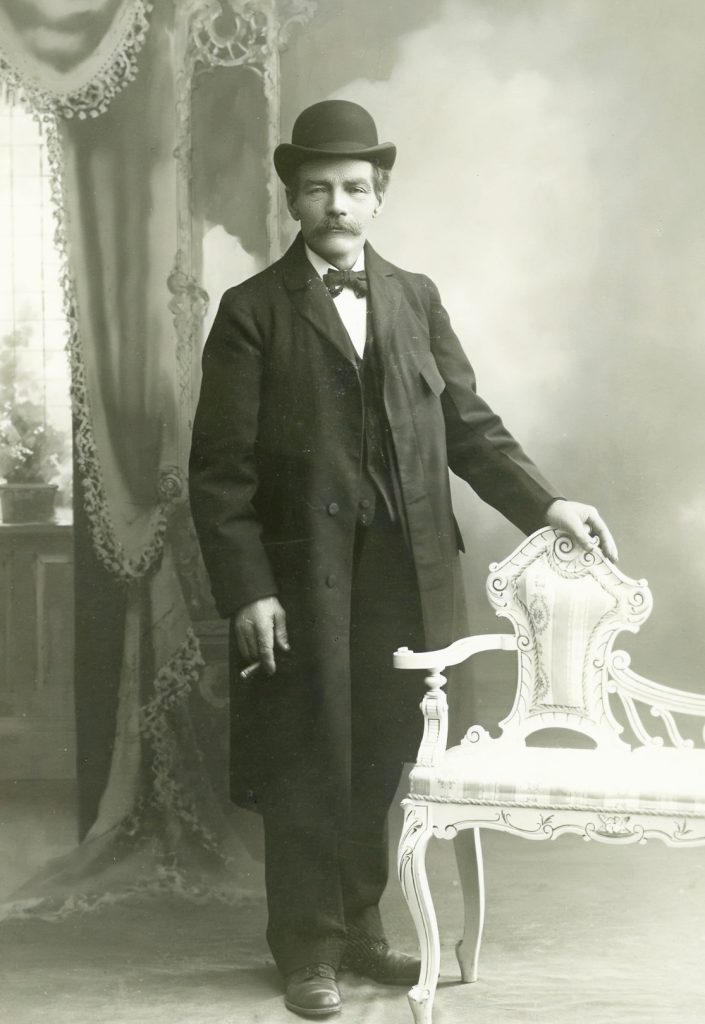
Trondheim is a port half-way up the coast of Norway, extremely distant from the family farm in Ullensaker. In order to secure passage and set aside a stake for his journey to America, Gunder probably worked as a sailor, fisherman or longshoreman on the docks of the city. In 1869, he secured passage on a steamship and left in search of a new start. Reviewing the census record of 1880, first son Samuel was said to have been born in Norway (error). The Minnesota census of 1775 indicates Samuel was born in Minnesota.
It was customary for most Norwegians to join friends and family who were already established in their new home. The earliest Norwegian immigrants settled on rich prairie farmlands in southeast Minnesota. Predominant Norwegian settlements were present in Goodhue and Houston counties. I have found in the 1880 census records an Olang Quarve (with three children) in Spring Grove Township, Houston County, Minnesota. More interestingly, Edvart L. Quarve (born 5/1850) is listed with his wife Geolina and six children in the 1900 census. Could he be a younger brother of Anna?
In 1869, Fred Frederikson (from Sor Trondelag south of Trondheim) led a party of sixteen up the Red River Trail from St. Cloud to Kandota township. Kandota is a Chippewa Indian name meaning “Here we rest.” The party wintered over in Sauk Centre. They built a small ‘hotel’ (16 by 40 feet). From that small start, the settling of Kandota began. Gunder Sorenson is listed on the 1870 census and was with this party. I mention this specifically because Fred Frederikson and his wife, Ellen, were godparents for Gunder and Anna’s second son Olaf and third son, Gulbrand (Gilbert), born 12/11/1876. Both Gunder and Anna Olsdatter (Kvarve) arrived in America in 1869 separately.
H. Gilman Sorenson recalls the eve of his Grandmother’s death. She was at the home of Gilbert (her son) and Anna Sorenson, suffering from shortness of breath and a terrible cough (she died of dropsy, known today as congestive heart failure). She talked all through the evening, recalling her life in Norway. She also recalled her journey to the States. Unlike Gunder, she secured passage on a sailing ship. One night, as all of the terrified passengers were kept below decks, a great pounding sound was heard and felt throughout the ship. Repeated pleas as to the cause were left unanswered. Finally, the pounding ceased and the passengers slept. The next day, the captain announced that a whale had been battering the ship. He had said nothing the night before; he was apparently as fearful as the passengers that the hull of his ship might be breached and all might perish in the cold north Atlantic.
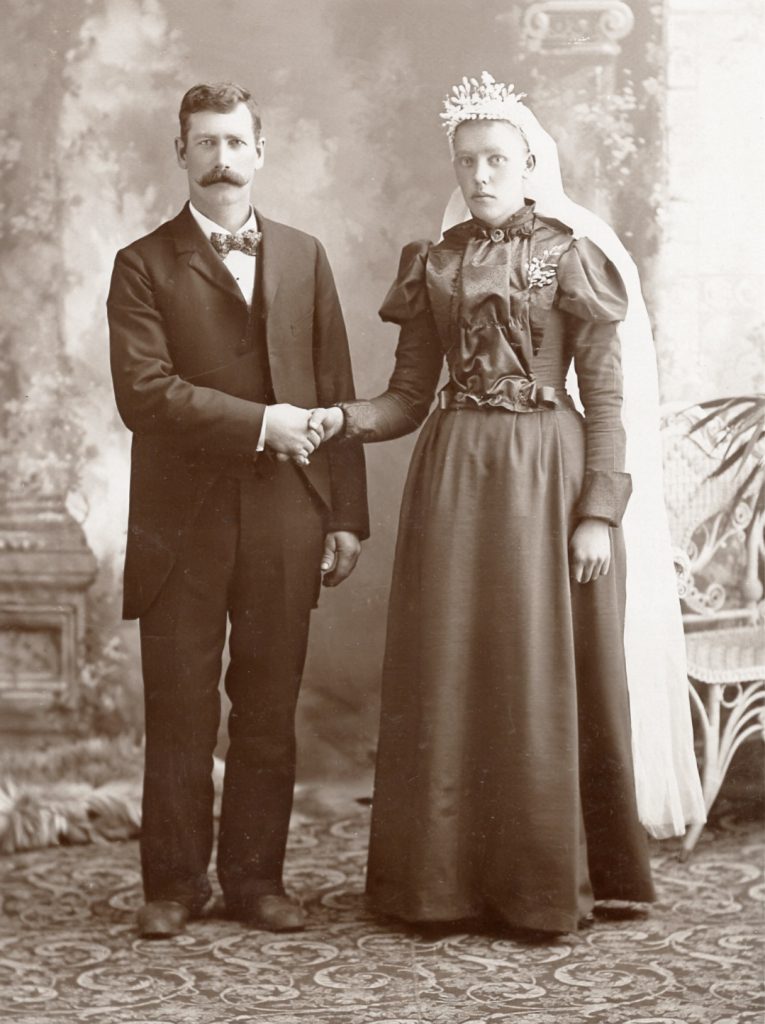
Gunder Sorenson marrie Anna Olsdatter , photo taken at Johnson Photo studio in Sauk Centre, MN.
By 1871 latest, Gunder and Anna were together. They were married in 1872 according to the census. Long Bridge church records started in 1872, there is no record of their union. Their son, Samuel, was born April 1872. According to the 1870 census, Gunder was a farmer in the Norwegian community of North Fork Township, Stearns County, Minnesota (fourteen miles SSW of Sauk Centre). His possessions were valued at $200. Review of the 1871 Kandota County tax list indicates that he had not yet settled in Todd County. They claimed a quarter-section of part prairie, part densely wooded land (160 acres) on the southeast portion of Section 9, Township 27 of range 34, Todd County, Minnesota. Review of the Homestead Receiver’s office records (then located in St. Cloud, MN) produces a final receiver’s receipt #3600 for application #6103. “Received of Gunder Sorenson the sum of $4 being the balance required by law…” The land was proved and paperwork completed 7/18/1881. On 8/10/1876, Anna Sorenson borrowed $200 at ten percent interest from the New England Mortgage Security Company, using the homestead as collateral. She signed her name with an ‘X.’ The lien was removed on 4/15/1885. On 12/20/1893, Anna Sorenson purchased the southwest corner of section 9 for the sum of $1000 ($400 of which was from Ormus Marshall, who at the time owned the land by default on a previous note). Two additional purchases of eighty acres each were later made on adjoining section 10 land to the south. This brought the Sorenson holdings to 520 acres on sections 9 and 16.
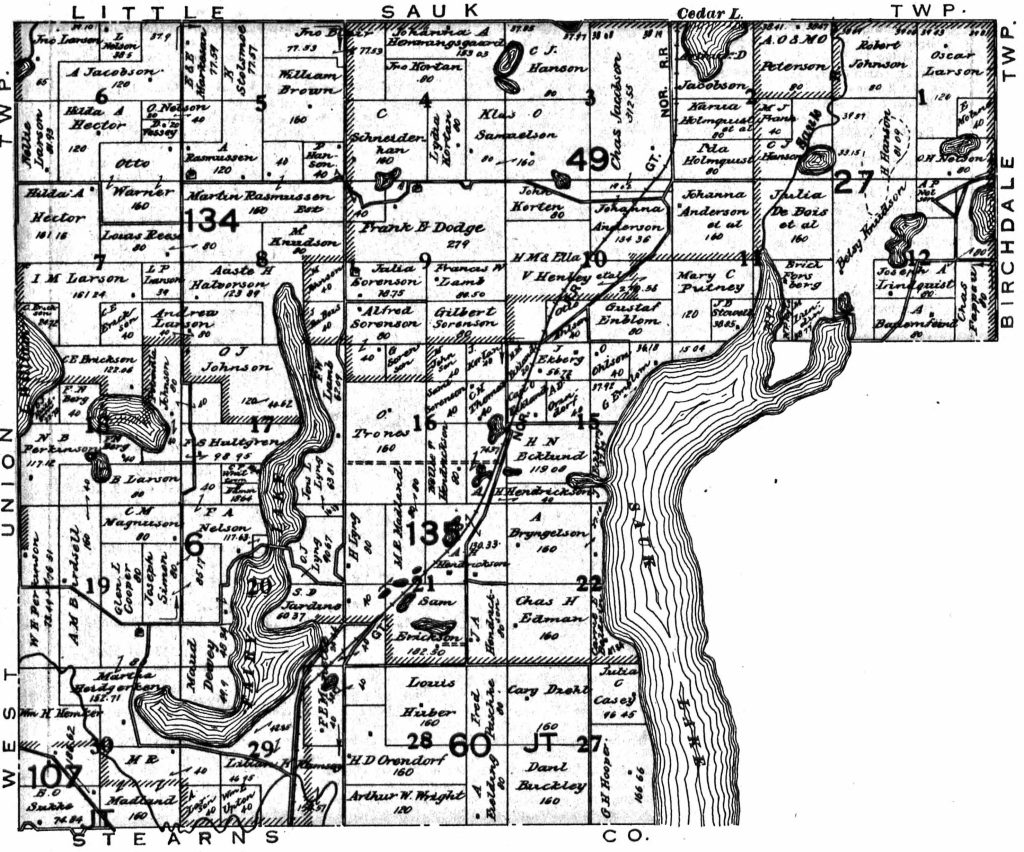
Kandota Township about 1920
John 0. Klukken wrote a serial article in 1957 for the centennial edition of the Osakis Review. He was a local historian who recalled the lives of the early settlers of Gordon Township, Todd County, Minnesota. I include information from this in order better portray early pioneer life in Todd County.
It is written that Vikings discovered America (scientifically verified in Newfoundland but not proven that they ever traveled to Minnesota). According to theory, they even sailed Sauk Lake, following Sauk River from Lake Osakis. Up until 1857, the arrival of the first white settlers, the area was rich with wildlife, a paradise for the Indians. The Sorenson homestead lay near the fluid boundary between the Chippewa and Sioux Indians. It is likely that with enough patience, arrowheads might still be found, witness to Indian hunting parties as well as battles.
When Gunder arrived, Kandota Township lay fifty miles from the closest railroad in St. Cloud. The land was virgin and unspoiled. While the last of the Indian uprisings occurred in the early 1860’s, Indians were often seen in the area (and saved the lives of more than one local settler who was close to starving). The woods teemed with wildlife, including deer, bears and wolves. The woods were so thick that it was difficult to find one’s way to the nearest neighbor. Trees were marked with an ax in order for settlers to find their way from one hut to the next.
The hardest thing to tackle for the early settlers in the wooded area was to grub and clear the land for crop purposes. If ever anything took determination and “the sweat of thy brow,” here it was. It took only to look at the shaking and calloused hands and fingers of the pioneers to know that they had put into the job more strength than they really had, at least many of them. It would take one man with a grub hoe and an axe normally one month to grub one acre, and another to clear the logs and brush and break it. The process of clearing a field was indeed slow in coming.
For the Sorenson family, winter was the best time to work in the timber. The Sorenson homestead was located in Kandota Township, Todd County, between Fairy Lake to the west and larger Sauk Lake to the east. Gilman Sorenson recalls that his father Olaf, with brothers, would load up a sleigh full of wood, head cross country to the frozen lake, then travel up the lake to Sauk Centre. There, the load would fetch a dollar. If the weather was good, the boys would get back late in the evening, If not, they might have to spend the night in Sauk Centre. I wonder what kids today might do to earn a dollar, not for themselves, rather for the benefit of the entire family.
There was little to distract one from the grueling daily routine. Imagine a life without television, radio or theater. While Gunder was literate, Anna was not. The children were allowed to attend school until the age of ten or eleven. After that, they were too busy with farm work to waste their time elsewhere. The primary distraction for many of these early settlers, including the Sorenson family, was the church. There was a long tradition of organized religion in the Fladby farm in Norway dating back to the fourteenth century (the farm was church property under the aegis of the bishop). Gunder was baptized in the church, along with all of his sisters. In Minnesota, Gunder was one of the early co-founders of the Kandota Congregation Lutheran Church. The church was built on his land, just north of the house. In 1892, the Kandota and Long Bridge congregations joined. They shared a pastor for a few years, and finally the Kandota Church was vacated. The only remnant is a graveyard. Sorenson family members are interred at the Long Bridge Church cemetery. Services were conducted entirely in Norwegian, and all of the children were confirmed in Norwegian. Small wonder thus that the Sorenson children were barely literate in English.
The Sunday trek to church was not one to be taken lightly. While Long Bridge Church was only four miles distant, the trip was generally made on foot. The presence of adverse weather (rain, sleet or snow) could make this a miserable journey. Once there, the entire community met for the regular church services as well as social gatherings afterwards. For many women, this was their only regular contact with friends and neighbors, the only break in a daily routine of work and more work. All of the Sorenson children were confirmed; presumable both at Kandota and at Long Bridge Lutheran Church. A list of the couple’s children follows:
Samuel April 1972-1929 is not listed as living with his family in the 1895 Census. Sam married Ronnag ‘Rosie’ Anderson (born Oct 1859 in Norway, died 17 Apr 1935 in Ramsey, MN) on 25 Nov 1895 in New Ulm, Stearns Co, MN at Big Grove Lutheran Church in Brooten. Ronnag ‘Rosie’ was 13 years his senior, and they had one daughter, Anna Mathilde Sorenson. The family lived in Burnhamville Townhip, Todd Co in the 1900 census. The family occupied the farm, a 40 acre plot in the northeast corner of section 16, Kandota Township, in the 1910 census. In the Ramsey Co phonebook of 1928, Ronnag is listed as a widow, suggesting that the couple were never formally divorced. Daughter Anna Mathilde Sorenson married Paul P Pirvu in 1922.
Sam then married (?) Selvina Anderson, about 1915. Sam was 43 and Selvina 17. Selvina was living with her aunt and uncle at the time. They had their first child Sibert, who was born in St. Cloud MN. The family immigrated to Alberta, Canada in 1917. Their second child, Gladys Jeanette Sorenson was born in Kiscoty, Vermilion River, Alberta 17 Jul 1917. Their third child, Alice Myrtle, was born in Prince Albert, Saskatchewan on 14 Nov 1919, where the family settled. In the 1926 prairie census, the entire family is listed. In the 1931 census, Selvina in living as head of household with seven children. Sam died in 1929 at the age of 57.
Olaf 10/8/1875-3/18/1945 (please see dedicated blog on Olaf and Annie)
Gilbert 12/11/1876-2/8/1950 (please see dedicated blog on Gilbert and Anna)
Markus 1/13/1877-1/31/1908. MarkAll Postsus was baptized at Long Bridge Church in Little Sauk, MN 2 Feb 1977. In 1905, Markus and Otelius are living in Hendrickson Township, Hubbard County south of Bemidji. Markus had been a resident farmer for five years, Otelius one year as listed on the census. On 4 Jan, 1907, Markus visited his grandparents in Little Falls, MN with father Gilbert and sister Malla. Markus died of tuberculosis 1 Jan 1908 at the family farm at the age of 30.
Edward 7 Jan 1879- 14 Feb 1934 was born in on the family farm. He married Hanna Flan 28 Nov 1907. They lived for nine years in Sauk Centre and then moved to the home place in Kandota. He was baptized, confirmed married and died at the Long Bridge Lutheran Church. On his WW1 draft card, he worked for the Great Northern RR as a section laborer. In the 1930 census he is listed as a farmer in Little Sauk Township. Prior to his death, he had been in poor health for four years. Edward and Hanna had two children, Cora Sorenson who married Sturri Larson Jan 1932 (no children) and Goodwin Thorwald Sorenson who married Alverna Mae Nelson (Edward Emil, Robert Eugene and Robyn Carol).
Otelius 10/7/1880- 4/24/1907 was baptized at the Long Bridge Church on 7 Nov 1880. In the 1900 census, Otelius is living on the family farm with Markus, Albert, Hanna, Alfred and Malla. In the 1905 census Otelius is living with Markus in Hendrickson Township, Hubbard county. One wonders if the boys moved away from the family due to the scourges of tuberculosis. Otelius died of tuberculosis in 1907 at the family farm.
Albert 4/31/1882-1/13/1910 married on 3 Jul 1907 Julia Elizabet Freeberg (born 13 May 1883 in Dals-Ed, Västra Götaland, Sweden, daughter of Josef Andersson Friberg and Ida Andersdatter). They had two children, Genard Julian and Eva Amelia (Granlund). Albert died of tuberculosis at the age of 27. Julia, Gennard and Eva are listed on the farm in the 1910 census, with sister-in-law Hannah Sorenson. After the death of Albert, Julia married Olaf Samuelson 1 Aug 1918 (son Verner Samuelson).
Genard was born 10 May, 1908 on the family farm. In the 1920 census, Genard is living with Alfred and Malla Flan (they raised him after the death of his father Albert). He and sister Eva Amelia were confirmed at Little Sauk Lutheran Church 28, Oct 1923 (same class as Harry Gilman Sorenson). In the 1930 census, Genard is a lodger in Hennepin Co, living with Sibert Flan. He was a cashier for a coal firm at the time. He married Esther Isaak 31 Dec, 1931 in Todd County.
Long Prairie Leader 14 Jan 1932: Little Sauk Young Lady Weds. Miss Esther L Isaak, of Little Sauk Township, and Mr. Genard Sorenson, of Minneapolis, were married in Minneapolis New Year’s Eve by Rev. Theo. H Schrodel. The ceremony was performed at midnight. The bride was attired in a royal blue formal gown trimmed with gold and silver beads. She also wore black moire pumps and carried a bouquet of pink tea roses and baby breath. Attendants at the wedding were Miss Alpha Nelson, Mr. Sibert Flan and Mr. and Mrs. Morris Cook. Following the ceremony a reception was held at the home of Mr. and Mrs. Walter Zastrow at 1 o’clock. The ceremony started shortly after midnight and the wedding vows were exchanged just as the new year ushered in. The bride is the daughter of Mr. and Mrs. F. J. Isaak of Parkston, SD. Mr. Sorenson is the son of Mr. and Mrs. Alfred Flan, of Little Sauk Township. He is a graduate of the Long Prairie High School, the teacher training department here and the Minneapolis Business College. For the past two years he has made his home in Minneapolis, where he is employed as a cashier of the Pittsburg Coal Company. Mr. and Mrs. Sorenson will make their home in Minneapolis.
In the 1940 census, Genard is living outside of Little Sauk with Alfred and Malla Flan. He was employed, a trucker in the beer industry, divorced at the time. His home at the time of the census was actually in Long Lake, Mound, MN. He married his second wife, Vida Mae Pogue 27 Jul 1940 in Iowa.
Genard served in WWII in the army from 19 Oct 1943 to 16 Nov, 1945.
Genard married his third wife Francis Lucile Gleason 28 May, 1948 in Codington, SD. They lived in Minneapolis, and had one son, Richard Julian Sorenson (born 7 Jul 1950) one daughter Karen Sue Sorenson (born 20 Dec 1951). Genard died 8 Nov 1956 aged 48. Both he and Francis are interred in the Long Bridge Cemetery in Little Sauk, MN.
Eva Amelia Sorenson married Eric William Granlund and had a daughter, Lillian Elizabeth Granlund. Lillian married Herschel Russell and had five children (Dale, Noelle, Nancy, Dorene and Douglas).
Geolina 12/15/1883-1956. In the 1910 census, Geolina is living with Albert’s widow Julia, son Gennard and daughter Eva Amelia on the farm.
Alfred 11/08/1885- 2/2/1954
Malla 12/12/1887- 3/19/1962 married Gilbert ‘Alfred’ Flan on May 9, 1908 at the Sorenson family farm. Witnesses were Alfred Sorenson and Genora Flan. Malla and Alfred lived south of Little Sauk township just outside of town. east of Hwy 71. In 1906 both Malla and Geolina traveled to Little Falls to visit her mother’s family. Alfred and Malla had no children, they raised nephew Genard Sorenson after the death of older brother Albert. Genard was listed with the family on both the 1920 and 1940 census. They lived in a small place outside of Little Sauk, MN. Jan Sorenson Stenoien recalls that the Albert Sorenson family would stop off and visit periodically to visit.
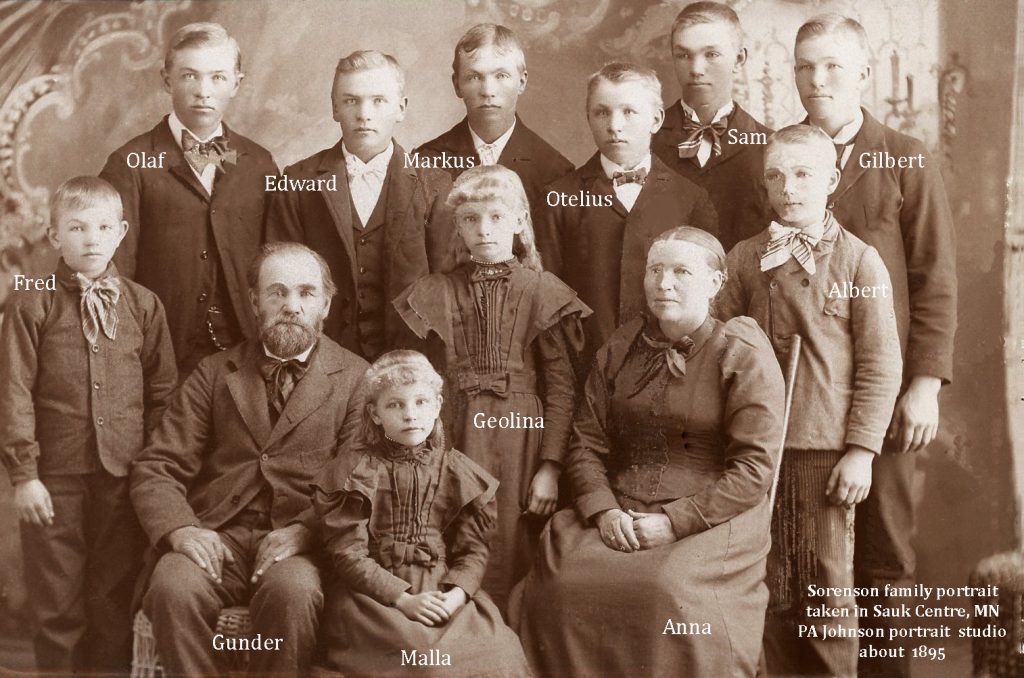
Gunder Sorenson was known as a very diligent farmer, a hard worker who demanded much of himself and his boys. Not only did the boys work in the fields and do their chores, they were also expected to help clean the house and do the dishes. Gunder purchased the first steam-powered thrasher in the area. He oversaw the operation, while Olaf worked the pumper and Gilbert stoked the steamer. The outfit required two teams of horses. The Sorenson family thrashed oats for themselves and neighbors. In August of 1905, Gunder developed an abscessed tooth. This was well before the era of antibiotics, and before a doctor could arrive, he succumbed to a systemic infection. He was 68 years old.
In the 1910 census, Annie Sorenson is living with son Alfred on the farm.
Very little is known about Anna Olsdatter. After the death of her husband, she lived primarily with her youngest daughter Malla, and husband Fred Flan. Each summer, she would join one of her children for two weeks at a time. At the time of her death, she was staying at the home of (son) Gilbert and Anna Sorenson. Alice Sorenson Lunde recalls that she spent almost all of the time in a rocker. Alice was unable to talk to her, since Anna spoke only Norwegian. Al Sorenson recalls being scolded by her for tossing his coat on the floor. Being younger (he did not learn English until he started school), he still understood enough to get the gist of her message. She passed away in her sleep during the night of October 22, 1923 at the age of 78.
